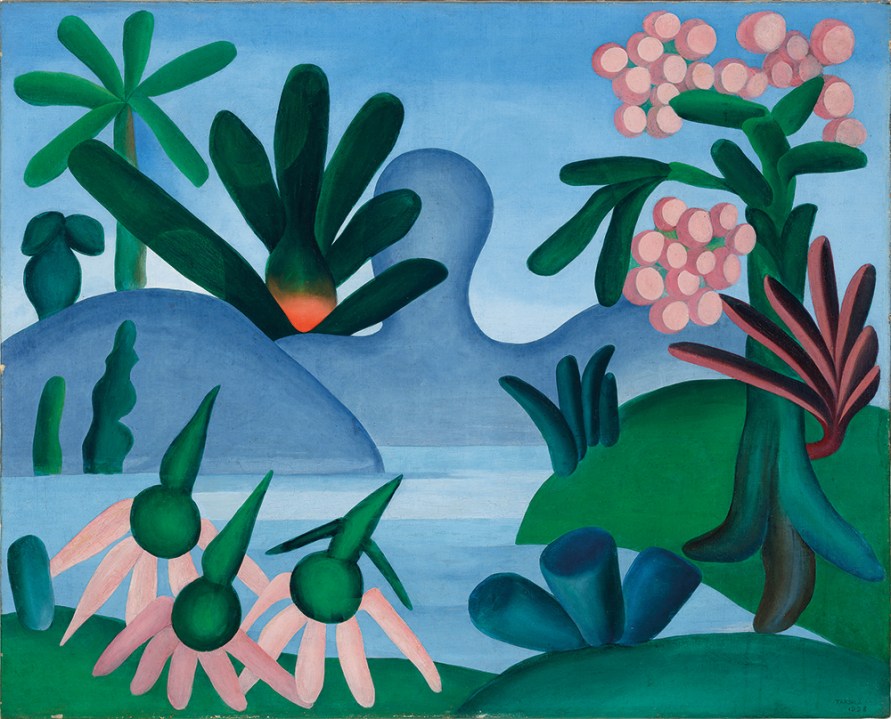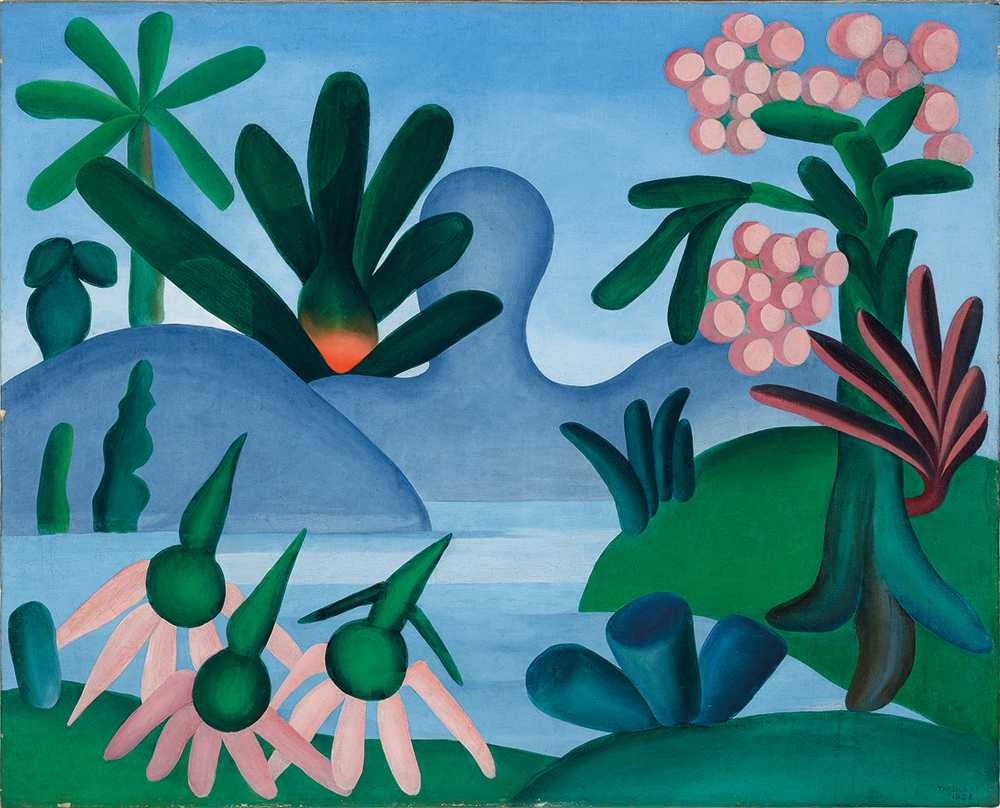
A paradox of art history: to understand the artists of the past, it helps to study how, and where, they conceived of the future. If today we foresee the future in the East, previous generations looked westward. In the last century, Europeans, having inherited a seemingly aged and decrepit civilisation, determined that the future of art was to be found in the New World. That much is well known. But this did not always mean America. Indeed, the true cognoscenti had a different country in mind: Brazil.
Brazil’s modernists proudly integrated all traditions – European, Amerindian, African, Asian
For the Austrian writer Stefan Zweig, it was Brazil that was the Land of the Future: the title of a book he wrote in his final years, which were spent exiled from the Nazis not far from Rio de Janeiro. It was written alongside his bestselling elegy for Europe, The World of Yesterday. One mourns Europe’s suicide; the other celebrates Brazil’s birth. Brazil, Zweig optimistically writes, was ‘a new kind of civilisation’.
This utopian fantasy of Brazil was surprisingly popular in the 20th century. Little trace of it remains, except, perhaps, for the testimony of its still functioning capital Brasilia, a sprawling city-sized concrete spaceship designed by the avant-garde Brazilian architect Oscar Niemeyer. But where did this peculiar conception of Brazil come from? How did it arise?
Brasil! Brasil! The Birth of Modernism, a groundbreaking exhibition at the Royal Academy, brings back into view the invention of the modernist movement in Brazil by looking at its pioneering painters – above all Anita Malfatti and Tarsila do Amaral – tracing their legacy in the visual arts from 1910 onwards. Implicit in the title is a subtle provocation; it hints at the possibility that Brazil was the birthplace of modernism tout court. Conventionally, the lineage of modernism is traced to a European point of origin, to wit Paris or London or Berlin. The curators suggest, however, that Brazil may stake just as much of a claim to being modernism’s progenitor. And if we are to pinpoint a city that could rival Europe’s great cultural metropoles, it would have to be Sao Paulo.
In this prosperous cosmopolitan city, booming from the coffee trade, populated by wealthy merchants as well as a highly multicultural immigrant working class, a new social order was forged around the turn of the century. It was from here that the coffee barons proclaimed a republic, abolishing monarchy, imperialism and slavery. Even the Brazilian flag, dating from this time and in its own right a minor masterpiece of abstraction – those colours! That rhombus! – has emblazoned on it the motto ‘order and progress’, a rousing quotation from that French prophet of reason, the philosopher Auguste Comte.
In this climate of accelerating modernity, explosive aesthetic experiments soon ensued. All of the so-called ‘Grupo dos Cinco’, the group of five visionaries who founded the modernist movement in Brazil, including Malfatti and do Amaral, were born in Sao Paulo in the late 19th century to solid bourgeois families. Mercantile wealth paid first for their highly traditional art school formations, then, crucially, for excursions to Europe to unlearn all that tradition. Eclectic influences – expressionism from Germany, cubism from France, futurism from Italy – began showing up in Sao Paolo galleries during the first world war, which Brazil sat out.
But the turning point came in 1922, that annus mirabilis of modernism, at least as far as the English-speaking world is concerned, when Joyce’s Ulysses, T.S. Eliot’s The Waste Land and the English translation of Proust’s In Search of Lost Time were all published. In an event of arguably comparable significance, Sao Paulo played host to the Semana de Arte Moderna (Modern Art Week), a festival of all the arts, from painting to poetry, in which the Brazilian modernists coalesced for the first time as a movement with a shared, public vision.
The Semana is now commemorated as one of the major events in Latin American history. The public didn’t see it that way at the time. The vibe was very much épater la bourgeoisie, and the bourgeoisie responded in kind. Audiences hooted at the great modernist composer Heitor Villa-Lobos during the concerts he gave, scandalised, among other things, by the conductor’s choice of footwear: flip-flops. The public flocked to Malfatti’s paintings only to jeer at them. Critics abused her: she was ‘deformed’ – a pun on the literal meaning of her name – but that was not the wisecrack her critics thought it was, for her cubist-influenced paintings deliberately de-formed and re-formed the bodies of the women she portrayed, devoid of the romanticism then expected of women’s bodies.
Ridiculed by the cultural establishment, Malfatti must have felt rather like the subject of her now much-lauded painting, ‘A Boba’ (Silly Woman, 1915). Here, in a gesture typical of modernism, the subject’s inner life, her feelings of alienation, are depicted physically – an unveiling of mind over matter. But Malfatti’s paintings became more conservative after the reaction to the Semana. A pronounced European complexion prevailed over them, albeit with a tropical colour palette – lots of yellow, green and blue, the very colours of the Brazilian flag, critics like to note. But it seems unlikely that there was any crude nationalist symbolism intended; she was simply inspired by the same landscape of sand, sea and jungle.
Against Malfatti’s more European orientation, do Amaral went in a more radical direction. Though she, too, had an apprenticeship in Europe, do Amaral sought to express what was unique to Brazil, its forms and flavours, its moods and mythologies. ‘A Negra’ (The Black Woman, 1923) acknowledged, almost for the first time, the African constituency in Brazilian society – who were, in fact, the numerical majority, something that set the country apart from the rest of the continent.
With strange, surreal images, do Amaral sought to re-mythologise Brazil and its people. Her most famous paintings, ‘Abaporu’ (1928) and ‘Anthropophagy’ (1929), depict earthy figures reminiscent of pre-Columbian art, single-breasted, one-footed. This alluded to the monopod, a loathsome creature that was said by Europeans to inhabit exotic parts, as well as to the cannibals who, according to legend, lurked in the jungle. (The words ‘abaporu’ and ‘anthropophagy’ mean ‘the man who eats human flesh’ in an Amerindian tongue and Greek, respectively.) But do Amaral’s monopods and cannibals are nothing like the malevolent creatures depicted by Europe’s medival artists; they are unthreatening, solitary beings, serenely lazing in the sun against a background of soft, smooth cacti, the barbaric wilderness tamed into something cosy and humane – in other words, into a home.
De Andrade argued that Brazilians were destined to be cultural cannibals
This pictorial mythography of Brazil was monumentally influential. The poet Oswald de Andrade, one of Sao Paulo’s original famous five, was inspired by do Amaral’s paintings to set out the Anthropophagic Manifesto, which would consume the art scene for decades. Proudly reclaiming an ancient European slur, de Andrade argued that Brazilians were destined to be cultural cannibals, devouring all the influences they encountered, digesting and transmuting them into a uniquely Brazilian national tradition channelling all the sources of its culture. This would become the most important theoretical influence on the later artists exhibited here, notable among them Candido Portinari, a communist of a more realist bent, whose mural-like paintings – e.g. ‘Mestiço’ (1934) – honoured the diverse peoples of the land.
There was, naturally, a reaction against this school of thought. The postwar Brazilian art scene tacked towards a more rational, abstract style that turned away from national sentiment. The Concrete artists, for example, favoured rigorous geometry and even, in the case of sculpture, engineered forms. Among them were some major artists – none of whom are represented in this exhibition – such as Lygia Clark, who disavowed colour entirely, repudiating tropical revelry, and Mira Schendel, whose pristine blank spaces contrast with the tumescent landscapes of the anthropophagists. It would have been interesting to exhibit this backlash, but the Royal Academy has, perhaps understandably, opted for coherence over contradiction.
Today the nations of the formerly colonised global south – and Brazil is the largest in the southern hemisphere – are of surging importance to the future. In this context, the modernists of Brazil hint at an alternative to our existing paradigms, whether Eurocentric or postcolonial (both of which ultimately mirror each other in the way they counterpose the West and the rest). How much more appealing, then, is the society envisioned by the anthropophagists, proudly integrating all the world’s traditions – European, Amerindian, African and even Asian (Brazil has the world’s largest Japanese and Arab diasporas) – within an outlook that doesn’t discriminate between the foreign and the native. Perhaps Zweig was right; the compass may yet point to Brazil as the civilisation of the future.
Brasil! Brasil! The Birth of Modernism is at the Royal Academy from 28 January until 21 April.








Comments